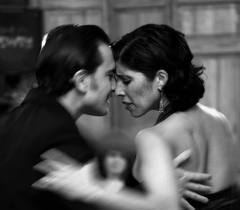He leads, she follows. This is the simple truth of tango. Because of this, many have the misconception that tango is a man’s dance. But this is not true. Tango is a dance of equals – different and equal. Read on, you’ll see.
Tango, the music and the dance, was borne with the European immigration wave to Argentina in the 1880’s. The immigrants were mostly men who came from Italy, Germany and Greece, and settled in the orillas or outskirts of Buenos Aires. Thus many of the songs are melancholy – they speak of lost love and loneliness, desperation and unfulfilled passion. The dance itself started between men and then moved to brothels, where the women would dance to attract customers. But this is not a history lesson, I am simply trying to trace some of the roots of Tango to highlight the fact that it too, was stereotyped by the cultural norms of the time. However, when you dance it , if you want to dance it well, you immediately understand that it is a dance that requires both masculine and feminine energy, in more or less equal parts that have to be negotiated constantly and in partnership. It is perhaps, the only dance that requires the equal participation of the dancers in order to be fluid, so I find it useful to use Tango to think about gender roles and stereotypes and about what happens when the embodiment of masculine and feminine energy (in all of their conventional and clichéd formulas) actually flows.
Yes it is true that in Tango the man leads and the woman follows. This is true even when two women or two men dance together: the masculine energy leads, the feminine follows. Hmmm. What does that actually mean? In actuality what it means is that the leader has to initiate the dance, choreograph his steps, stay alert in the line of dance so as to not run into anyone else, and most importantly, through his embrace, communicate and invite the woman to move with him. Huh! And it looks so smooth. The leader has to know what the step looks like backwards, so that he can make room for his partner to move. Being a good leader is very difficult – he is always a little ahead of the beat so that he can move his partner onto her feet with the beat, and then follow her movement into the next step. A good leader has a light touch but a strong presence. And so it is for the follower. Now since the man initiates the movement, the woman (the follower) has to be receptive to his invitation. She moves only when he moves, and does not set her foot down in a step until the man has moved her there. This requires physical awareness and sensitivity. It is the subtle exchange of mutual understanding through the embrace that literally moves the center of balance from two separate individuals to one – the couple. This requires trust, as both partners are constantly counter balancing each other and sharing the other’s weight. This connection creates security and confidence in the partnership. In Tango the center of weight is between the dancers so that they may become one.
If you are still with me, and not wanting to immediately jump up and dance, then you probably have caught on to where I am going with this. The leader leads and follows. The follower follows and leads. Moving as one requires two people who are present and negotiate their energy constantly. Masculine and feminine energies. Fluidity of movement requires negotiation not just between leader and follower but between the masculine and feminine energies of both partners. Individually and together. When the movement is powered by two equally involved and present energies the gender of each participant matters not. It literally creates a fluid, interactive loop. Such is the dance of Tango. Such is the interplay of sexuality and gender in life – a subtle negotiation between the masculine, the feminine and the possibilities in between.
He says: Make me wait for you. She moves into him and adjusts the pressure of her embrace. The center of gravity shifts. They dance as one, both balancing in each others’ embrace. Uh huh. A magical moment. A communion with the fluidity of our being, in sexed reality and gendered energy.


